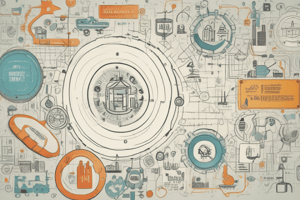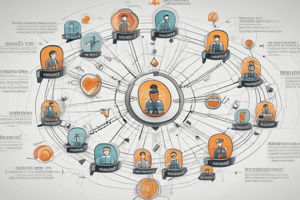Podcast
Questions and Answers
What is the primary focus of technical controls in information security?
What is the primary focus of technical controls in information security?
- Physical security measures
- User education and training
- Organizational policies and procedures
- Application of modern technologies (correct)
What does the strategy of Defense in Depth involve?
What does the strategy of Defense in Depth involve?
- Focusing solely on employee training
- Using a single layer of controls for protection
- Utilizing multiple layers of different types of controls (correct)
- Applying only managerial controls
What is redundancy in the context of information security?
What is redundancy in the context of information security?
- Creating multiple security policies for one system
- Using multiple types of technology to enhance security (correct)
- Eliminating all risks to data security
- Restricting access to only one backup system
What defines a security perimeter?
What defines a security perimeter?
What is the primary goal of a Security Education, Training, and Awareness (SETA) program?
What is the primary goal of a Security Education, Training, and Awareness (SETA) program?
Which aspect does security training emphasize for employees?
Which aspect does security training emphasize for employees?
What must occur when communication takes place between different security domains?
What must occur when communication takes place between different security domains?
Which of the following is NOT a component of the Defense in Depth strategy?
Which of the following is NOT a component of the Defense in Depth strategy?
What is the primary role of the Policy Administrator in an organization?
What is the primary role of the Policy Administrator in an organization?
Why is it important to periodically review policies?
Why is it important to periodically review policies?
What mechanism should a policy manager implement to facilitate policy reviews?
What mechanism should a policy manager implement to facilitate policy reviews?
What could happen if policies are drafted and published without dates?
What could happen if policies are drafted and published without dates?
What is the purpose of a sunset clause in a policy?
What is the purpose of a sunset clause in a policy?
What does automated policy management primarily aim to streamline?
What does automated policy management primarily aim to streamline?
What is a potential consequence of not keeping policies current?
What is a potential consequence of not keeping policies current?
How can a policy manager ensure approved improvements are implemented effectively?
How can a policy manager ensure approved improvements are implemented effectively?
What is the primary purpose of the Information Security Blueprint?
What is the primary purpose of the Information Security Blueprint?
Which of the following best describes the role of an Information Security Framework?
Which of the following best describes the role of an Information Security Framework?
What distinguishes managerial controls from operational controls in information security?
What distinguishes managerial controls from operational controls in information security?
Which of the following is included in operational controls?
Which of the following is included in operational controls?
What does the Sphere of Protection designate?
What does the Sphere of Protection designate?
In the context of security measures, what does the Sphere of Safety require?
In the context of security measures, what does the Sphere of Safety require?
Which aspect is not typically a part of the Information Security Model?
Which aspect is not typically a part of the Information Security Model?
Which of the following best represents a challenge organizations face when implementing an Information Security Blueprint?
Which of the following best represents a challenge organizations face when implementing an Information Security Blueprint?
Flashcards
Policy Management
Policy Management
The process of creating, maintaining, and managing security policies within an organization.
Policy Administrator
Policy Administrator
A designated individual responsible for creating, revising, distributing, and storing security policies.
Schedule of Reviews
Schedule of Reviews
Regular review of policies to ensure they are up-to-date and accurate.
Review Procedures and Practices
Review Procedures and Practices
Signup and view all the flashcards
Policy and Revision Date
Policy and Revision Date
Signup and view all the flashcards
Sunset Clause
Sunset Clause
Signup and view all the flashcards
Automated Policy Management
Automated Policy Management
Signup and view all the flashcards
Security Policies
Security Policies
Signup and view all the flashcards
Information Security Blueprint
Information Security Blueprint
Signup and view all the flashcards
Information Security Framework
Information Security Framework
Signup and view all the flashcards
Design of Security Architecture
Design of Security Architecture
Signup and view all the flashcards
Spheres of Security
Spheres of Security
Signup and view all the flashcards
Sphere of Protection
Sphere of Protection
Signup and view all the flashcards
Managerial Controls
Managerial Controls
Signup and view all the flashcards
Operational Controls
Operational Controls
Signup and view all the flashcards
Sphere of Use
Sphere of Use
Signup and view all the flashcards
Technical Controls
Technical Controls
Signup and view all the flashcards
Defense in Depth
Defense in Depth
Signup and view all the flashcards
Redundancy
Redundancy
Signup and view all the flashcards
Security Perimeter
Security Perimeter
Signup and view all the flashcards
Security Domain
Security Domain
Signup and view all the flashcards
Security Education, Training, and Awareness (SETA)
Security Education, Training, and Awareness (SETA)
Signup and view all the flashcards
Security Training
Security Training
Signup and view all the flashcards
Security Education
Security Education
Signup and view all the flashcards
Study Notes
Policy Management
- Policies are living documents needing ongoing management.
- They must be properly distributed, read, understood, agreed to, and uniformly applied.
- Components of security policies include:
- Responsible Manager: Also known as the Policy Administrator, this role is responsible for the creation, revision, distribution, and storage of policies in an organization.
- Schedule of Reviews: Policies need periodic reviews for currency and accuracy in a changing environment, then modified accordingly. Outdated policies can become liabilities.
- Review Procedures and Practices: Mechanisms should be implemented for policy reviews (e.g., email, office mail, anonymous drop box). All comments are examined and approved improvements are implemented.
- Policy and Revision Date: Dating policies is often omitted but crucial; confusion can arise without dates. Some policies require sunset clauses to define an expiration date, particularly those governing short-term business associations.
- Automated Policy Management: Software automating policy writing, tracking, approvals, publishing, and employee reading and acknowledgement, streamlining the process.
The Security Blueprint
- The security blueprint outlines organization's overall information security strategy, providing a roadmap for changes.
- Often based on methodologies like NIST's or ISO 27000 series.
- Information Security Model: An established framework, often popular among organizations and backed by recognized security agencies, suitable for emulation.
Design of Security Architecture
- The spheres of security:
- Sphere of Security: Measures protection against intruders.
- Sphere of Use: Area where someone can use something safely or freely.
- Sphere of Protection: Designates an area in which a person is legally permitted to protect another person.
- Sphere of Safety: Attentiveness to hazards (overhead, underground, surrounding).
Key Differences
- Key aspects of security spheres:
- Sphere of Use: Interaction of users with information.
- Sphere of Protection: Security controls protecting information and systems.
- Sphere of Safety: Physical and environmental security.
- Main elements differ in each sphere: users, devices, processes; data, systems, networks; physical environment, infrastructure.
- Goals in each sphere: secure usage and access; maintain confidentiality, integrity, and availability; protecting against physical and environmental risks.
- Examples of security controls specific to each sphere.
- Sphere of Use: authentication, endpoint protection
- Sphere of Protection: firewalls, encryption, access control
- Sphere of Safety: surveillance, fire suppression, backup power
Level of Control
- Levels of security controls: managerial, operational, technical
- Managerial Controls: Administrative planning of security programs focusing on governance and risk management.
- Operational Controls: Lower level planning that directly deals with the functionality of organizational security. Examples include disaster recovery and incident response planning.
- Technical Controls: Security safeguards applying modern technologies (e.g., firewalls, VPNs, IDPSs) to protect information assets.
Defense in Depth
- A strategy protecting information assets using multiple layers of managerial, operational, and technical controls for optimal security.
- Redundancy: Using multiple types of technology to prevent one system from compromising information security.
Security Perimeter
- Security Perimeter: Boundary separating an organization's security efforts from the outside world or untrusted network areas.
- Security Domain: A trusted area where information assets share the same level of protection. Each trusted network is a domain. Communication between domains requires traffic evaluations.
Security Education, Training, and Awareness Program
- Security Education, Training, and Awareness (SETA): A managerial program improving information asset security through targeted knowledge, skills, and guidance for organizations. This enhances security by:
- Increasing awareness of system resource protection needs.
- Developing computer user skills and knowledge for secure operation.
- Building in-depth knowledge to design, implement, or operate security programs for organizations and systems.
- Security Training: Providing detailed information and hands-on instruction to equip employees for secure duties.
- Security Awareness: Implementing programs to proactively promote security awareness amongst users via various media.
Studying That Suits You
Use AI to generate personalized quizzes and flashcards to suit your learning preferences.




